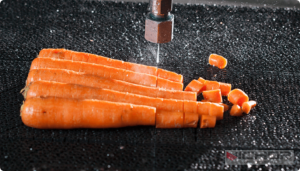
What Is Waterjet Efficiency and How to Achieve It in Your Cutting Processes?
Waterjet cutting technology has revolutionized manufacturing and fabrication industries by offering precise, versatile, and environmentally friendly cutting solutions. At the heart of this technology lies the concept of waterjet efficiency, which refers to the optimal use of resources—such as water, energy, and abrasives—to achieve high-quality cuts with minimal waste and cost. Understanding waterjet efficiency is crucial for businesses aiming to enhance productivity, reduce operational expenses, and maintain a competitive edge. In this article, we will delve into multiple aspects of waterjet efficiency, providing insights into its definition, influencing factors, measurement techniques, improvement strategies, and economic benefits. By the end, you will have a comprehensive grasp of how to leverage waterjet efficiency for better outcomes in your operations.
Understanding Waterjet Efficiency
Waterjet efficiency is a measure of how effectively a waterjet system converts input resources into desired cutting output. It encompasses factors like cutting speed, accuracy, material utilization, and resource consumption. High waterjet efficiency means achieving precise cuts with less water, lower energy usage, and reduced wear on components, ultimately leading to cost savings and extended equipment life. This aspect of waterjet efficiency is vital because it directly impacts sustainability and profitability. For instance, an efficient system minimizes water wastage and energy drain, aligning with eco-friendly practices while boosting bottom-line results. By focusing on waterjet efficiency, operators can ensure that their processes are not only effective but also economically and environmentally responsible.
Key Factors Influencing Waterjet Efficiency
Several elements play a critical role in determining waterjet efficiency. First, pump pressure is a primary driver; higher pressures often lead to faster cutting speeds and better precision, but they must be balanced against energy consumption to maintain optimal waterjet efficiency. Second, nozzle design and condition affect the focus and velocity of the water stream, influencing cut quality and resource use. Third, the type and quality of abrasives used in abrasive waterjet systems can significantly impact efficiency—using the right abrasive in the correct proportion reduces waste and enhances cutting performance. Fourth, material properties, such as hardness and thickness, require adjustments in parameters to sustain high waterjet efficiency. Finally, system maintenance, including regular checks for leaks and component wear, ensures consistent performance. Neglecting any of these factors can lead to decreased waterjet efficiency, resulting in higher costs and lower productivity.
Measuring and Monitoring Waterjet Efficiency
To improve waterjet efficiency, it is essential to have reliable methods for measurement and monitoring. Key performance indicators (KPIs) include cutting speed, which should be optimized to avoid unnecessary delays or errors; water consumption rates, measured in gallons per minute, to ensure resource efficiency; and energy usage, tracked through power consumption metrics. Additionally, the kerf width—the material removed during cutting—can indicate efficiency, as a narrower kerf often means less waste and better material utilization. Regular audits and software tools can help track these metrics, providing data-driven insights into waterjet efficiency. By continuously monitoring these parameters, operators can identify inefficiencies early and make informed adjustments, thereby maintaining peak waterjet efficiency over time.
Strategies to Enhance Waterjet Efficiency
Improving waterjet efficiency involves adopting best practices and technological advancements. One effective strategy is optimizing cutting parameters, such as pressure and traverse speed, based on material type and thickness. This ensures that the system operates at its peak without overusing resources. Another approach is implementing advanced control systems, like CNC integration, which enhance precision and reduce human error, thereby boosting waterjet efficiency. Regular maintenance schedules, including nozzle replacement and pump servicing, prevent downtime and maintain consistent performance. Using high-quality abrasives and recycling systems can also contribute to better waterjet efficiency by reducing material costs and environmental impact. Furthermore, operator training is crucial; skilled personnel can make real-time adjustments to uphold high waterjet efficiency. By combining these strategies, businesses can achieve significant improvements in their cutting processes.
efficiency. Regular maintenance schedules, including nozzle replacement and pump servicing, prevent downtime and maintain consistent performance. Using high-quality abrasives and recycling systems can also contribute to better waterjet efficiency by reducing material costs and environmental impact. Furthermore, operator training is crucial; skilled personnel can make real-time adjustments to uphold high waterjet efficiency. By combining these strategies, businesses can achieve significant improvements in their cutting processes.
The Economic Advantages of High Waterjet Efficiency
High waterjet efficiency translates directly into economic benefits for organizations. By reducing water and energy consumption, companies can lower utility bills and operational costs. Efficient systems also minimize material waste, leading to savings on raw materials and disposal fees. Moreover, improved cutting accuracy and speed enhance throughput, allowing for faster project completion and increased revenue. Over time, maintaining high waterjet efficiency can extend equipment lifespan, reducing capital expenditures on replacements and repairs. In competitive markets, these cost advantages enable businesses to offer better pricing or invest in innovation. Thus, focusing on waterjet efficiency is not just a technical goal but a strategic financial decision that drives long-term growth and sustainability.
In conclusion, waterjet efficiency is a multifaceted concept that encompasses resource optimization, performance metrics, and economic outcomes. By understanding its key aspects—from defining it to implementing improvement strategies—businesses can unlock greater productivity and cost savings. As technology evolves, staying informed about waterjet efficiency will be essential for maintaining a competitive edge. We hope this article has provided valuable insights into how you can achieve and sustain high waterjet efficiency in your operations.
Frequently Asked Questions About Waterjet Efficiency
Q1: What is waterjet efficiency and why is it important?
A1: Waterjet efficiency refers to the effectiveness of a waterjet system in using resources like water, energy, and abrasives to produce high-quality cuts with minimal waste. It is important because it directly impacts operational costs, environmental sustainability, and overall productivity. High waterjet efficiency leads to lower expenses, reduced resource consumption, and improved cutting performance, making it a key factor for businesses seeking to optimize their manufacturing processes.
Q2: How does pump pressure affect waterjet efficiency?
A2: Pump pressure plays a significant role in waterjet efficiency by influencing cutting speed and precision. Higher pressures can enhance efficiency by allowing faster cuts and better accuracy, but they also increase energy consumption. Therefore, balancing pressure settings with material requirements is crucial to maintain optimal waterjet efficiency without unnecessary resource drain.
Q3: Can waterjet efficiency be measured, and what metrics are used?
A3: Yes, waterjet efficiency can be measured using various metrics, such as cutting speed, water consumption rates, energy usage, and kerf width. These key performance indicators help monitor how well the system is performing. Regular tracking through software or manual audits allows operators to identify areas for improvement and ensure sustained waterjet efficiency.
Q4: What are some common ways to improve waterjet efficiency?
A4: Common ways to improve waterjet efficiency include optimizing cutting parameters (e.g., pressure and speed), performing regular maintenance on components like nozzles and pumps, using high-quality abrasives, implementing advanced control systems, and providing operator training. These strategies help reduce waste, enhance precision, and lower operational costs, thereby boosting overall waterjet efficiency.
Q5: How does waterjet efficiency impact long-term costs?
A5: Waterjet efficiency has a substantial impact on long-term costs by reducing expenses related to water, energy, materials, and equipment maintenance. Efficient systems minimize waste and downtime, leading to lower utility bills and material costs. Additionally, they extend equipment lifespan, decreasing the need for frequent replacements. This makes high waterjet efficiency a cost-effective investment that supports financial sustainability and growth.
continue reading

